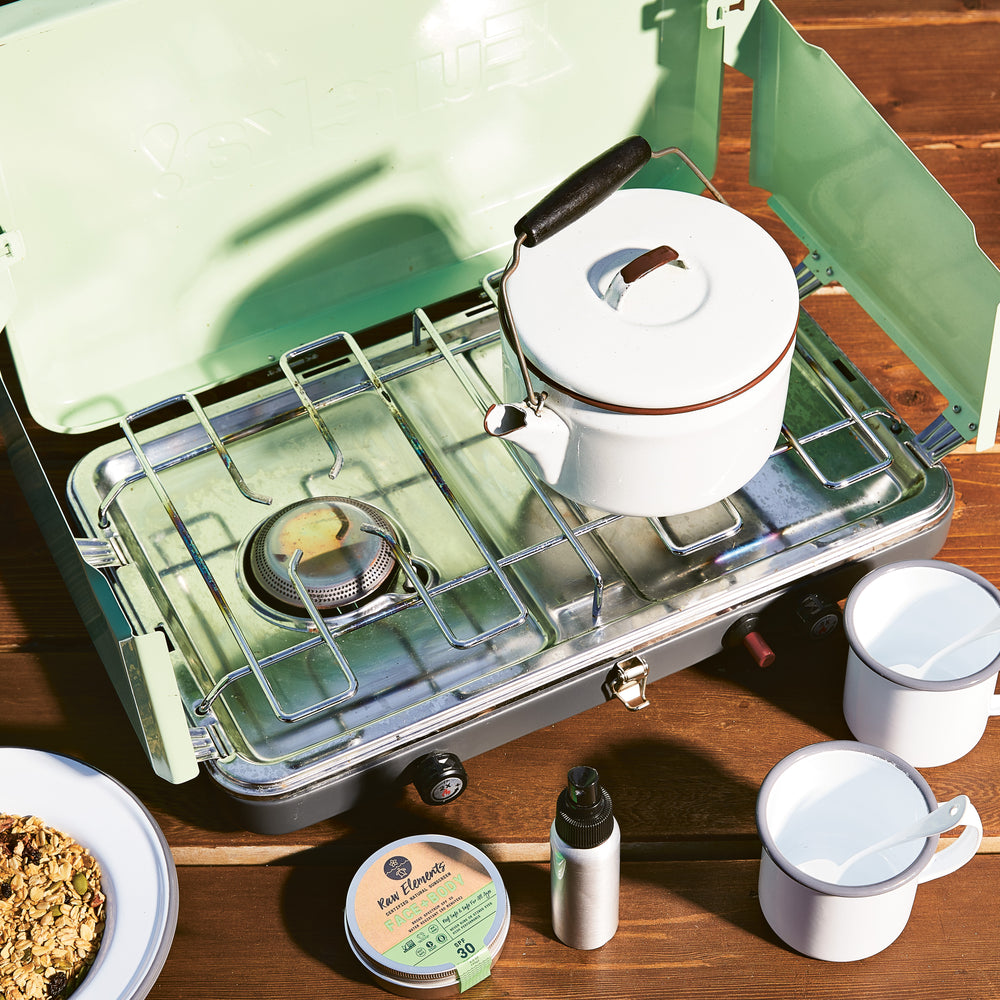Spending time outdoors is a great way to connect with nature and your motivation for reducing waste. And yet, being outside the home without access to a stove, sink, recycling or compost bucket can present some serious obstacles to living zero waste. When it comes to camping, most people will turn to the convenience of packaged foods and single-use products that are lightweight and easy to dispose of such as granola bars, paper napkins and plastic sandwich bags. But, wouldn’t it be nice if we could immerse ourselves in nature and leave zero waste behind? Here are a few tips to help you minimize your camping footprint:
1. Skip packaged meals. Food always seems to taste better after a long day of strenuous outdoor activity. While a trip to any outdoors store will present an array of dehydrated meals in vacuum-sealed pouches, you can easily pack low-waste meals that are every bit as compact and convenient, and wayyy more tasty than dehydrated curry. Visit the bulk foods aisle at the grocery store for inspiration—rolled oats for breakfast, dried pasta or a soup mix for dinner. For snacks, consider trail mix, granola, dried fruit or homemade bars. Pack everything in reusable silicone sandwich bags or beeswax wraps. If you want to bring fresh produce, you might want to prep it ahead (to remove non-edible ends and seeds) and try to consume perishable items first. Remember to pack out any food scraps to compost at home, though you’ll probably be so hungry you won’t need to!
2. Don’t forget reusables. Come prepared with reusable cutlery, water bottles, cloth napkins or bandanas and a lightweight container to eat out of. If you’re camping somewhere remote with no potable water access, you may want to bring a water purifier to fill up bottles from lakes or streams. If you’re backpacking, you’ll probably want to skip containers that are heavy or bulky like glass and ceramic and use light materials like a collapsible silicone bowl and bamboo cutlery. While we usually prefer using stainless steel water bottles, we like to bring BPA-free Nalgenes for backpacking since they’re light, easy to fill up and we don’t mind if they get scuffed up.
3. Keep it simple. When it comes to toiletries, you’ll want to leave most things behind. Forgo multi-step beauty routines for simple self care—a bar of soap to wash your hands, face, body and meal gear, sunscreen in a metal tin or aluminum bottle, a bug repellent stick in a compostable tube and toothpaste or baking soda. Some extras to consider include deodorant in a compostable tube (or scrub pits with soap), a small hairbrush (or keep long hair in braids) and a menstrual cup if it’s that time of month. Try to only bring unscented products made with biodegradable ingredients that won’t harm wildlife. If you are using soap or toothpaste, use it 200 feet away from water sources to avoid contamination.
4. Pack it out. Whenever we visit nature, the goal should be to leave it as clean (or more clean) than when you arrived. That includes food packaging, meal scraps and in some cases, toilet paper. If you are planning a remote backpacking trip without access to a bathroom, be sure to read up on local waste regulations regarding human waste. While some areas allow campers to dig a cathole to relieve themselves, other areas (especially at high-elevations and sensitive wildlife habitats) may ask campers to pack out solid human waste and tp in a container or bag. Look for a biodegradable option that can be easily disposed of when you return to the trailhead or back home. For peeing in the woods, stay 200 feet away from water sources and try the shake-dry method or use a reusable cloth that can be washed and dried. Wash hands with soap and water or use hand sanitizer.
5. For gear, borrow or buy second hand. If you’re new to camping, don’t go out and buy a bunch of fancy new gear—first, make sure that you like this whole sleeping outdoors without a shower thing. Start out by borrowing as much as you can from friends and family. But if you do need to buy something, try to find it secondhand through Facebook Marketplace and Craigslist. There are tons of people who had big dreams of living out a Wild fantasy and hiking the Pacific Crest Trail only to discover it wasn’t for them. You can find lots of brand new, great quality gear at a fraction of the cost and with no packaging waste.

